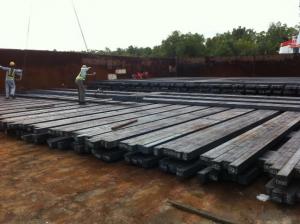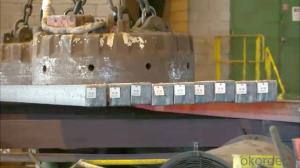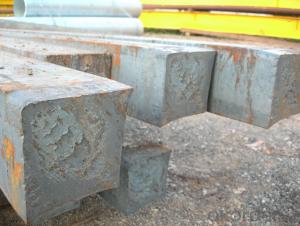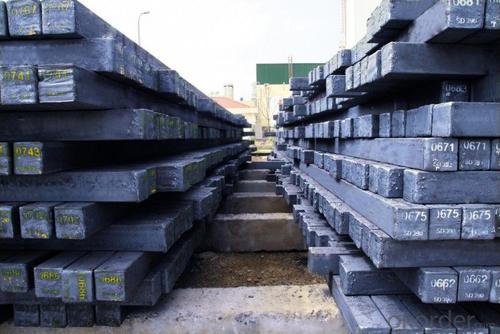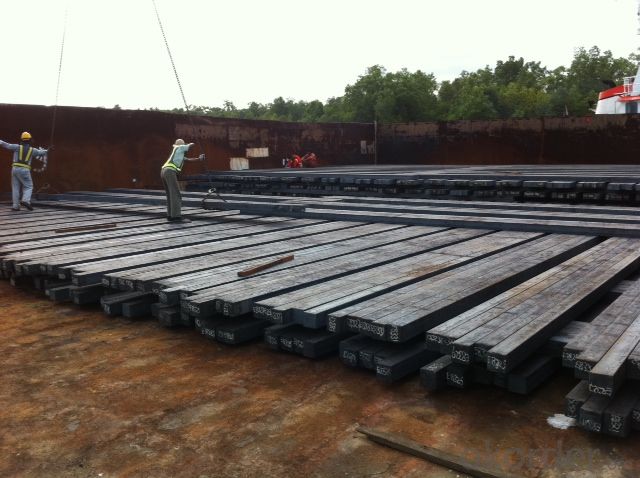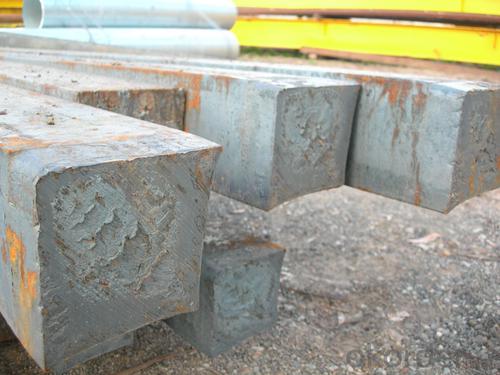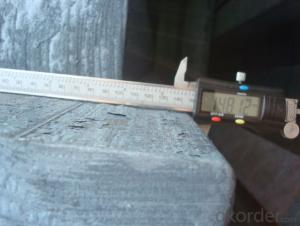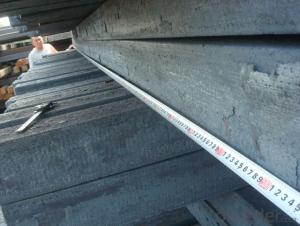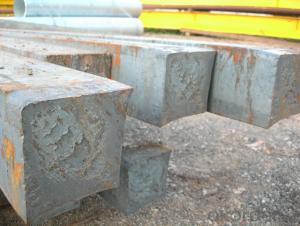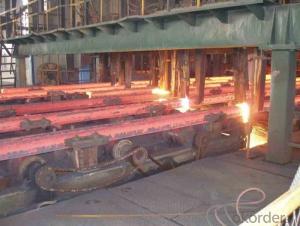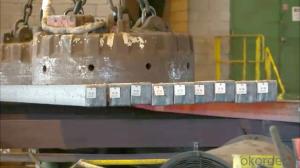Hot Rolled Square Steel Billet 3SP Standard 160mm
- Loading Port:
- Shanghai
- Payment Terms:
- TT OR LC
- Min Order Qty:
- 2000 m.t.
- Supply Capability:
- 10000 m.t./month
OKorder Service Pledge
OKorder Financial Service
You Might Also Like
Structure of Hot Rolled Square Steel Billet 3SP Standard 160mm

Description of Hot Rolled Square Steel Billet 3SP Standard 160mm
PPGI is made by cold rolled steel sheet and galvanized steel sheets as baseplate, through the surface pretreatment (degreasing, cleaning, chemical conversion processing), coated by the method of continuous coatings (roller coating method),
and after roasting and cooling. Zinc coating: Z60, Z80, Z100, Z120, Z180, Z275, G30, G60, G90
Alu-zinc coating: AZ60, AZ80, AZ100, AZ120, AZ180, G30, G60, G90
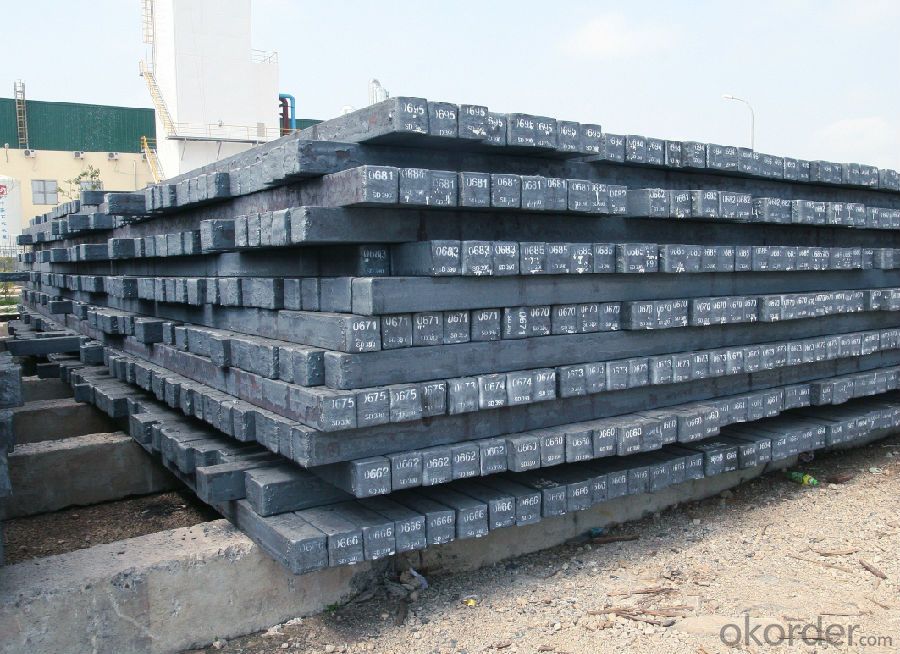
Main Feature of Hot Rolled Square Steel Billet 3SP Standard 160mm
1) Excellent corrosion resistance: The zinc layer provides a good protection of Pre-painted Galvanizeed Steel Sheet.
2) High heat resistance: The reflective surface of the material aids in efficiently reflecting the sunlight away and in turn reducing the amount of heat transmitted. The thermal reflectivity converts into energy savings.
3) Aesthetics: Pre-Painted Galvanized steel sheet is available in plethora of patterns and multiple sizes as per the requirements that given by our customers.
4) Versatility: can be used in the various areas.Standard seaworthy export packing: 3 layers of packing, inside is kraft paper, water plastic film is in the middle and outside GI steel sheet to be covered by steel strips with lock, with inner coil sleeve.
Applications of Hot Rolled Square Steel Billet 3SP Standard 160mm
1) Automotive bodies: filters, fuel tanks, etc.
2) Construction materials: roofings, welding pipes,
3) Electric and electronic appliances: computer cans, etc.
4) Steel cans: containers, etc.
5) Steel furniture: washing machines, refrigerators, microwaves, etc.
6) Drums
7) Office equipment: printer, recorders, etc.
8) Motors and transformers
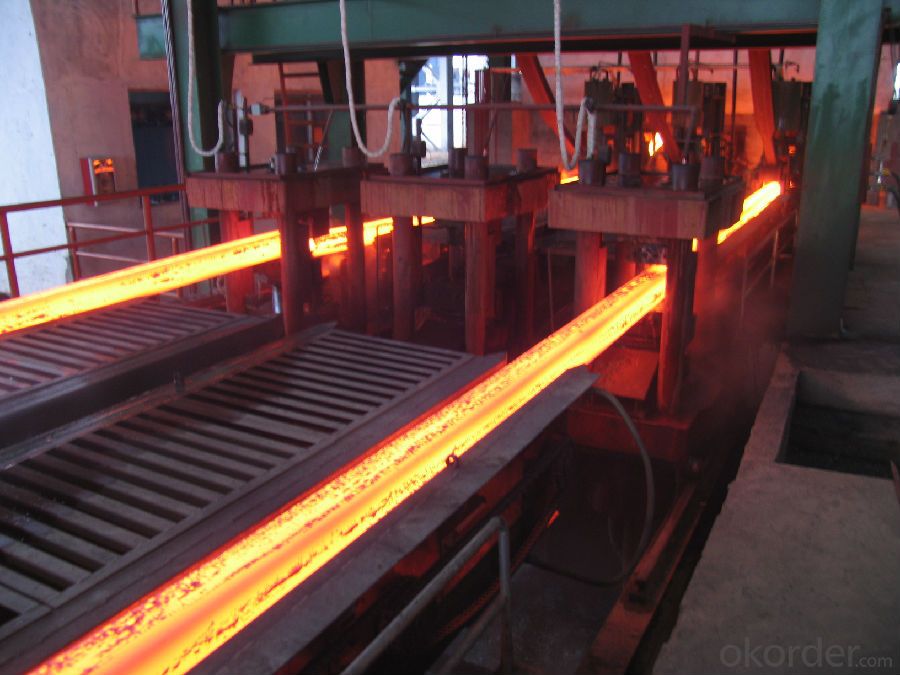
Specifications of Hot Rolled Square Steel Billet 3SP Standard 160mm
| Classified symbol | Yield Point Minimum N/mm2 | Tensile Strength Minimum | Elongation Minimum % | Application | ||||
| N/mm2 | Nominal Thickness mm (t) | |||||||
| JIS | Yogic | 0.25-0.4 | 0.4-0.6 | 0.6-1.0 | 1.0-1.6 | |||
| G3312 | specification | |||||||
| CGCC | CGCC | -205 | -270 | -20 | -21 | -24 | -24 | Commercial |
| CGCD | CGCD | --- | 270 | --- | 27 | 31 | 32 | Drawing |
| --- | CG340 | 245 | 340 | 20 | 20 | 20 | 20 | Structural |
| CGC400 | CG400 | 295 | 400 | 16 | 17 | 18 | 18 | Structural |
| CGC440 | CG440 | 335 | 440 | 14 | 15 | 16 | 18 | Structural |
| CGC490 | CG490 | 365 | 490 | 12 | 13 | 14 | 16 | Structural |
| CGC570 | CG570 | 560 | 570 | --- | --- | --- | --- | Structural |
| ASTM Designation | Yield Point Minimum | Tensile Strength Minimum | Elongation Minimum % | Application | Q/BQB 445-2004(China standard) | ASM A653/A653M | JISG 3312 | |
| ksi(MPa) | ksi(MPa) | TDC51D+Z | (CS TYPE A+Z) | CGCC | ||||
| A653(M)-99 CS TYPE A,B,C | --- | --- | --- | Commercial | TDC52D+Z | CGCD | ||
| A653(M)-99 FS | --- | --- | --- | Lock Forming | TS250GD+Z | (G250+Z) | - | |
| A653(M)-99 DS | --- | --- | --- | Drawing | TS300GS+Z | (G300+Z) | CGC 400 | |
| A653(M)-99 SS Grade33(230) | 33(230) | 45(310) | 20 | Structural | TS350GD+Z | (G350+Z) | CGC490 | |
| A653(M)-99 SS Grade37(255) | 37(255) | 52(360) | 18 | Structural | TS550GD+Z | (G550+Z) | CGC570 | |
| A653(M)-99 SS Grade40(275) | 40(275) | 55(380) | 16 | Structural | ||||
| A653(M)-99 SS Grade50(345) | 50(345) | 65(450) | 12 | Structural | ||||
| A653(M)-99 SS Grade80(550) | 80(550) | 82(570) | --- | Structural | ||||
FAQ of Hot Rolled Square Steel Billet 3SP Standard 160mm
We have organized several common questions for our clients,may help you sincerely:
1. How Can I Visit There?
Our company is located in Tianjin City, China, near Beijing. You can fly to Tianjin Airport Directly. All our clients, from home or aboard, are warmly welcome to visit us!
2. How Can I Get Some Sample?
We are honored to offer you sample.
3. Why choose CNBM?
1, ISO, BV, CE, SGS approved.
2, Competitive price and quality.
3, Efficient service team online for 24 hours.
4, Smooth production ability(50000tons/month) .
5, quick delivery and standard exporting package.
6, Flexible payment with T/T, L/C, Paypal, Kunlun bank, etc.
- Q: How is the strength of steel billets measured?
- The strength of steel billets is typically measured using a tensile test, where a sample is subjected to pulling forces until it fractures. The maximum force applied during the test is recorded and used to determine the strength of the steel.
- Q: What do you mean by adding carbon to a table tennis racket?
- What a professional? I don't know what is known but with carbon carbon line take this hit the ball the more comfortable to take shape
- Q: How are steel billets stored and transported?
- Steel billets, which are used for further processing, are carefully stored and transported to maintain their quality and safety. In terms of storage, steel billets are kept in designated areas within steel plants or warehouses, equipped with proper ventilation, drainage, and protection from the elements. They are organized in stacks with enough space between them for easy accessibility and inspection. To maximize space, steel billets are often stored vertically in racks or on specially designed shelves. This allows for easy handling and transportation. When it comes to transportation, heavy-duty equipment such as cranes or forklifts are used to move the billets safely, minimizing the risk of damage or injury. Chains or straps are used to secure the billets and prevent movement during transit. For longer distance transportation, steel billets are loaded onto trucks, trains, or ships. Containers or trailers are chosen based on the size and weight of the billets to ensure stability and safety. Proper weight distribution is crucial to maintain balance and prevent accidents. During transportation, it is important to protect the billets from moisture, extreme temperatures, and other external factors that could affect their quality. This may involve covering them with tarpaulins or using specialized containers. In conclusion, steel billets are stored and transported with great care to maintain their integrity and quality. Proper storage methods and suitable environmental conditions prevent damage and deterioration. Heavy-duty equipment and secure transportation minimize the risk of accidents. By following these practices, steel billets can be safely stored and transported, ready for further processing in the steel industry.
- Q: What is the typical surface finish of a steel billet?
- Depending on the specific application and processing method, the surface finish of a steel billet can vary. Generally, steel billets are produced with a rough surface finish that may have imperfections like scale, oxide layers, or minor irregularities. This is primarily because of the manufacturing process involving hot rolling or casting. Hot rolling is a common method for producing steel billets. In this process, the steel is heated to high temperatures and shaped by passing it through rollers. This high-temperature process can result in the formation of scale or oxide layers on the billet's surface, making it appear rough and textured. Similarly, steel billets produced through casting methods like continuous casting or ingot casting may also have a rough surface finish. During these processes, the molten steel solidifies in molds, leading to surface imperfections like cracks, pits, or unevenness. However, it's important to note that the surface finish of steel billets can be improved through additional processes such as descaling, shot blasting, or grinding. These processes help remove scale, oxide layers, or other imperfections, resulting in a smoother and more uniform surface finish. Furthermore, steel billets intended for specific applications like precision machining or forging may undergo additional surface treatments like polishing or coating to achieve the desired finish. In conclusion, the typical surface finish of a steel billet is rough and may have scale, oxide layers, or minor irregularities. However, various additional processes can be used to improve the surface finish according to specific requirements and applications.
- Q: What is the role of steel billets in the construction of underground tunnels?
- The construction of underground tunnels heavily relies on steel billets, which are cylindrical steel bars. These bars act as the primary raw material for manufacturing various structural components that are crucial in guaranteeing the stability and safety of the tunnel. One significant use of steel billets is in the production of rebar, also known as reinforcing bar. Rebars are inserted into the concrete walls and floors of the tunnel to provide tensile strength and prevent cracking or collapsing under the immense pressure exerted by the surrounding soil or water. These steel bars reinforce the concrete, making it more durable and resistant to deformation, ultimately enhancing the overall structural integrity of the tunnel. Moreover, steel billets are also utilized to create other essential tunnel components, including tunnel segments and steel arches. Tunnel segments are precast concrete elements that form the lining of the tunnel, often incorporating steel reinforcement for added strength. On the other hand, steel arches are employed in constructing tunnel roofs to offer extra support and stability. Additionally, steel billets are employed in the fabrication of various tunnel reinforcement systems like rock bolts and ground anchors. These systems help secure loose or unstable rock formations, preventing them from collapsing and jeopardizing the stability of the tunnel. Steel billets are also used in manufacturing tunnel supports such as steel ribs and beams, which provide additional strength and rigidity to the tunnel structure. In conclusion, steel billets are critical in the construction of underground tunnels. By being transformed into rebar, tunnel segments, steel arches, and reinforcement systems, they play a vital role in ensuring the structural integrity, stability, and safety of tunnels, ultimately facilitating efficient and secure transportation networks underground.
- Q: What are the potential applications of steel billets in the packaging aftermarket?
- Steel billets have various potential applications in the packaging aftermarket. They can be utilized for manufacturing sturdy and durable packaging materials such as steel drums, containers, and pallets. Steel billets provide excellent strength and impact resistance, making them ideal for protecting and transporting heavy or delicate goods. Additionally, their recyclability and sustainability make them a preferred choice for eco-conscious packaging solutions.
- Q: How are steel billets used in the production of oil and gas equipment?
- The production of oil and gas equipment heavily relies on steel billets, which act as vital components. These semi-finished steel products typically possess a square or rectangular shape and serve as the primary raw material for manufacturing various oil and gas equipment. Primarily, steel billets find their application in pipe production, playing a crucial role in the transportation of oil and gas from extraction sites to refineries or distribution points. After being heated, the billets are rolled into seamless or welded pipes, depending on specific requirements. These pipes are specially designed to endure high pressure, corrosive environments, and extreme temperatures, thus making them suitable for transferring oil and gas across long distances through pipelines. Furthermore, steel billets are utilized in the creation of valves and fittings, integral components of oil and gas equipment. Valves facilitate the control of oil and gas flow within pipelines, allowing for regulation and shut-off when necessary. On the other hand, fittings, such as connectors and couplings, ensure the proper connection and alignment of different pipe sections. Manufacturing these components typically involves forging or machining steel billets to guarantee strength, durability, and resistance to harsh operating conditions. In addition to pipes and valves, steel billets also play a significant role in the production of drilling equipment, including drill bits, drill collars, and drill pipes. These components are subjected to extreme forces and abrasive environments during the drilling process. To withstand such demanding conditions encountered during oil and gas exploration, steel billets undergo forging, heat treatment, and machining processes. In conclusion, the significance of steel billets in the oil and gas industry cannot be overstated. Their application in the manufacturing of pipes, valves, fittings, and drilling equipment is vital for the extraction, transportation, and processing of oil and gas. The exceptional strength, durability, and resistance to harsh conditions possessed by steel billets make them an ideal choice for constructing reliable and efficient oil and gas equipment.
- Q: What is the purpose of steel billets?
- The purpose of steel billets is to serve as raw material for various metalworking processes, such as forging, rolling, and extrusion. They are typically heated and shaped into different forms to create finished steel products like bars, rods, wire, and pipes.
- Q: What is the cost of producing steel billets?
- The cost of producing steel billets can vary depending on various factors such as the quality of the raw materials used, the production process employed, and the market conditions. Generally, the cost of producing steel billets includes several components. Firstly, the cost of raw materials, which typically include iron ore, coal or coke, and other alloying elements. The prices of these materials can fluctuate based on global market dynamics and availability. Secondly, the cost of energy is a significant factor in steel billet production. This includes the cost of electricity and fuel required for the manufacturing process, such as powering the blast furnaces or electric arc furnaces used to melt the raw materials. Thirdly, labor costs play a crucial role in the overall cost of production. This includes wages for skilled and unskilled workers involved in operating the machinery, maintaining equipment, and overseeing the production process. Additionally, there are indirect costs that need to be considered, such as maintenance and repair expenses for machinery, transportation costs for raw materials and finished products, and overhead costs related to administrative functions. It is important to note that the cost of producing steel billets can also be influenced by external factors like government regulations, tariffs, and taxes. Furthermore, market demand and competition can impact pricing strategies and ultimately affect production costs. Therefore, providing an exact cost figure for producing steel billets is challenging as it is subject to constant fluctuations. It is best to consult industry experts or steel manufacturers for the most accurate and up-to-date information on production costs.
- Q: What are the future trends in steel billet production?
- Improving efficiency, sustainability, and quality are the main areas of focus for future trends in steel billet production. One significant trend is the increasing use of advanced technologies in the production process. Automation and robotics are being adopted to streamline operations, minimize human error, and enhance productivity. Artificial intelligence and machine learning algorithms are also being employed to optimize production parameters and improve overall process control. Another trend involves a shift towards greener and more sustainable practices. Steel producers are investing in technologies that reduce carbon emissions, such as electric arc furnaces (EAFs) instead of traditional blast furnaces. EAFs consume less energy and emit fewer greenhouse gases, making them a more environmentally friendly choice. Furthermore, there is a growing emphasis on recycling and circular economy principles in steel billet production. Companies are investing in scrap metal recycling technologies to reduce reliance on raw materials and minimize waste. This not only conserves resources but also reduces the carbon footprint of steel production. Quality control is also a key focus for future trends. Steel producers are implementing advanced testing and inspection techniques to ensure the highest quality standards. Non-destructive testing methods, such as ultrasonic and magnetic particle testing, are used to detect any defects or flaws in the billets. In summary, the future of steel billet production is driven by advancements in technology, a commitment to sustainability, and a dedication to delivering high-quality products. These trends aim to make the steel production process more efficient, environmentally friendly, and economically viable in the long run.
Send your message to us
Hot Rolled Square Steel Billet 3SP Standard 160mm
- Loading Port:
- Shanghai
- Payment Terms:
- TT OR LC
- Min Order Qty:
- 2000 m.t.
- Supply Capability:
- 10000 m.t./month
OKorder Service Pledge
OKorder Financial Service
Similar products
Hot products
Hot Searches
Related keywords



